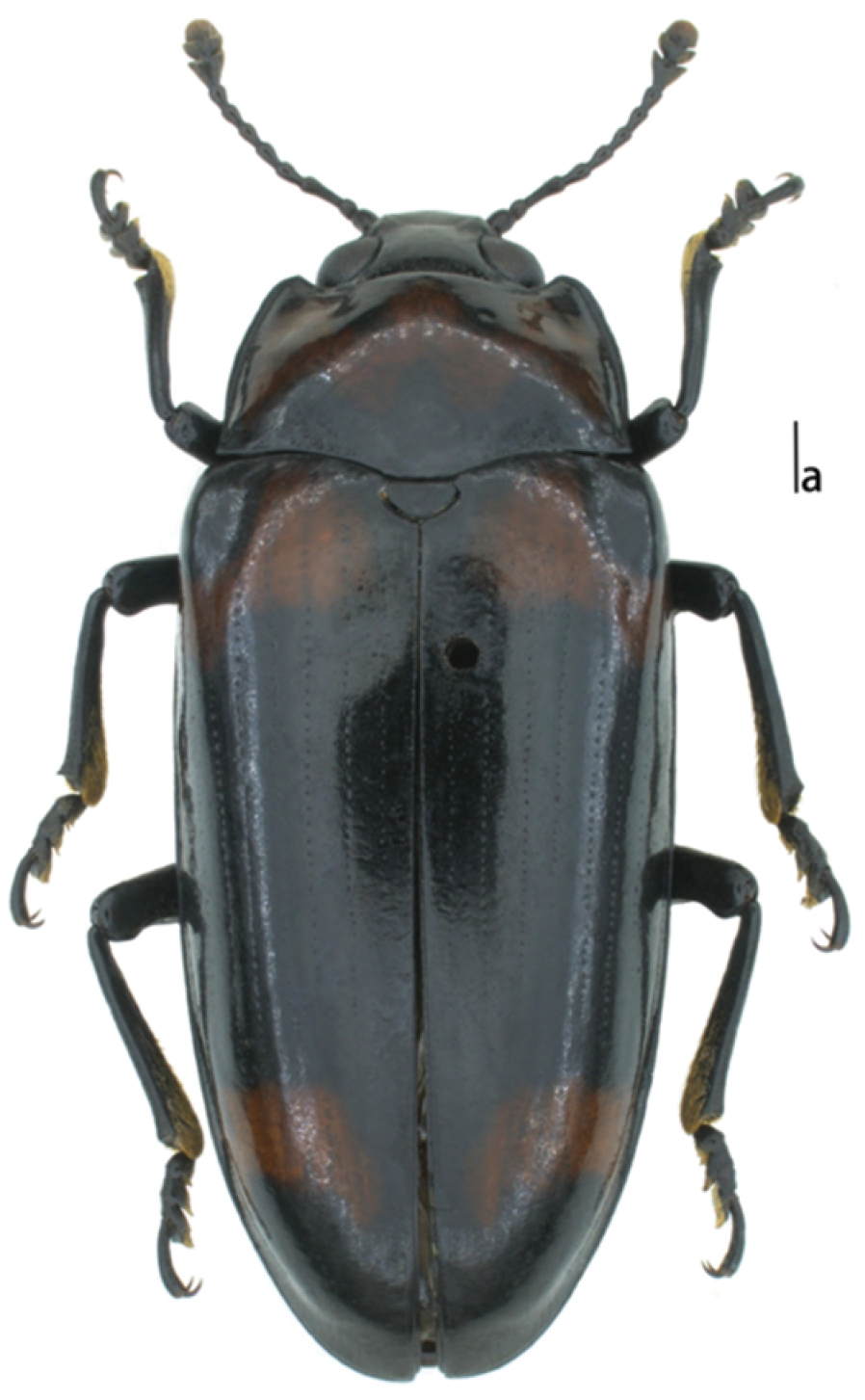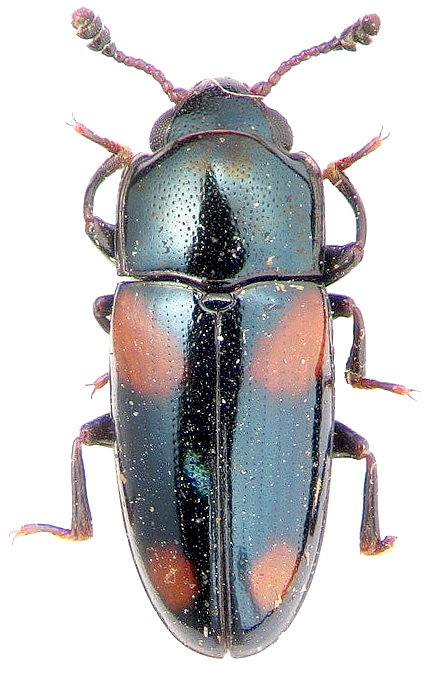Fotos / Sonidos
Observ.
gibbergavinDescripción
body length 7.5 mm; under bark on a rotting eucalypt log
Fotos / Sonidos
Observ.
lauriecooksonDescripción
Body 6-7mm. Antennal segment 3 significantly longer than 4 (helps tell genus). If all/most of pronotum was black, it would probably be Episcaphula duplopunctata obscuricollis. Under log on matt of fungus.
Fotos / Sonidos
Observ.
corinne1Descripción
Field Notes - Redish orange and black color pattern. Body about 15mm. I found this Beetle crawling on a dead tree in Fred Caterson recreation Reserve. I looks like an Episcaphula australis of the Erotylidae family.
Fotos / Sonidos
Observ.
gibbergavinDescripción
body length 8 mm (this is possibly Thallis atricornis?)
Fotos / Sonidos
Observ.
farananiDescripción
Between 1975 and 1986, an insect collection was collated by Anthony Cornel. Among the collection labels, A. Cornel, N.P. Gericke, and C. Shackleton are indicated as collectors. In an email to Professor Charlie Shackleton, an ecologist from Rhodes University, he recalls an entomology module as part of Zoology II in 1981 under Vincent James at the University of the Witwatersrand, where students had a practical assessment to collect insects.
At some stage, the collection was in the possession of Professor Leo Braack, author of “Field Guide to Insects of the Kruger National Park.” However, as he was leaving South Africa to focus on malaria research, it was passed on to Dr Cathy Dzerefos at the Tshwane University of Technology (TUT). Given the increasing significance of the iNaturalist app, georeferencing software, and the limited data available on insects, a new application for the collection has been made possible.
Fotos / Sonidos
Observ.
matthew_connorsDescripción
Okay, who's this little guy? My brain says Erotylidae, but there are no nearby sightings of any similar erotylids. That doesn't necessarily rule them out though. I do have a record of Erotylinae (with voucher specimen) from near here but I can't remember what it looks like. I think similar. Okay, let's have a look around the family then and see what we can do.
ALA gives us 6 erotylid subfamilies, four of which should be easy enough because they are not very diverse. Pharaxonothinae has only one species, Leucohimatium arundinaceum:

Xenoscelinae also has only one species, Xenocryptus tenebroides; I cannot find an image but here is a congener from Africa:

Loberinae has only two genera, Loberus:

and Hapalips:

Finally, Languriinae also contains only two genera. We have several Caenolanguria here on iNat:

and there is a good overview of the other species and genus here. From that we can safely rule them all out.
Cryptophilinae contains two tribes but only three genera (plus a couple of unplaced species). Cryptophilus is rather different and very tiny:

Here is Cathartocryptus:

I cannot find images of Protoloberus but I assume it is similar (or is it similar to Loberus above? Several sources place it there and it seems the ALA has some placement mixups. Oh well, they do not change the fact that it is none of these genera)
So indeed it is Erotylinae (assuming it is in fact an erotylid). ALA gives us three tribes - Dacnini, Encaustini, and Tritomini. Tritomini contains only the single species Hedista australiae:
Encaustini has three genera: Aulacochilus (2 spp.), Encaustes (1 sp.), and Micrencaustes (1 sp.). Here is E. hercules (for all the images of this size there is a larger image at the link but I cannot embed it):

Here is A. tetrasticta:

And oops, here is a paper describing a new species of Micrencaustes from Australia that the AFD hadn't included yet.... Goes to show I shouldn't trust them that much. I don't really have anything better though. But the paper indicates that the two species are very similar in pattern, and here is one of them (M. serratimaculata):

A. mocsaryi I cannot find any information on, but I assume it is quite similar to the other Aulacochilus so I am happy to rule it out.
So, Dacnini it is! What are the options? Quite a few unfortunately... AFD gives six genera: Cnecosa (5 spp.), Dacne (1 sp.), Episcaphula (17 spp.), Hoplepiscapha (2 spp.), Neothallis (5 spp.), and Thallis (17 spp.).
Dacne picta is an introduced pest:

Cnecosa it seems are rather skinny, parallel-sided beetles. Here is C. hoplostetha:

C. melancholica:

I cannot embed the image but C. insueta is here (as is Thallis vinula). I cannot find images of the other two Cnecosa but given how similarly-shaped the first three are I am happy to rule them out.
Hoplepiscapha would also appear to be quite distinct. Here is H. laticollis:

Further, this paper indicates that the genus has elongate antennomeres, so it is out. For completeness though here is H. longicornis:

That same paper also figures the types of Episcaphula tamburinea, E. clatrata, E. rufolineata (however these three are all synonyms), and Thallis bizonata (now in Neothallis).
On to the other Episcaphula then. Here is E. atromaculata:

E. duplopunctata actually looks quite similar but it has orange on the pronotum:

E. flavofasciata:

E. guttatipennis:

E. termitophila:

E. australis we have here on iNat:

Same with E. pictipennis:

E. rudepunctata is again similar but with orange on the pronotum:

No more Australian species on iNat or imaged on ALA, so I will have to dig deeper for the rest. A quick google of the names brings up no results however, so I may be at a dead end. And it seems that several new taxa have been described and some have been moved; for one thing Episcaphula is now in the tribe Megalodacnini. This paper describes two new genera (Echinothallis and Microdacne) which are thankfully both quite different to this one here, and a new species of Episcaphula, E. megalodacnoides. I cannot embed the image but the species is quite different to this one. Unfortunately it does not help much further though. I think for now at least I will move to the other genera.
Neothallis bizonata we have already seen; it is out. N. xanthosticta is here (although it is a different subspecies to the Australian one...):

The other Neothallis unfortunately I cannot find easily, but I have located this catalogue which should have the details of where to find the species descriptions of everything! That unfortunately will be quite a lot of work...
First I will move to Thallis. Here is T. atricornis:

T. basipennis:

Right off the bat these both look like very different beetles! T. compta we have here on iNat:

Same with T. dentipes:

T. femorata:

T. janthina:

T metasternalis:

The pattern on this one is similar but the pronotum is quite different. Indeed that would seem to be the case for the entirety of this genus, and the key here would seem to indicate that pronotal shape is a defining difference between the genera (although careful, because it only lists one species of Episcaphula.....). I will have a look at least for the remaining ones if they are easy to find.
T. serratipes:

T. subtuberculata:

T. tricolor:

T. vinula:

Okay, that's it for the ones with easy ALA pictures. But from the key linked above, most of those species of Thallis (and I suspect all species of Thallis...) have the pronotum narrower than the base of the elytra, as opposed to the same width, and the ones for which that character is not used are distinctly pubescent on top. This beetle clearly has the pronotom the same width as the base of the elytra, and it certainly looks glabrous to me, so I am happy to rule out all those species listed there. Of the ones we have not yet checked, they are T. bifasciata and T. erichsoni.
Okay, so what left in Thallis? Just four species: T. alternata, T. australiae, T. ferruginea, and T. occidentalis. There is an image on ALA of T. australiae but it has no associated record for some reason so I cannot tell whether or not it is accurate. However, based on the pronotal difference I am happy ruling out all four of these species. I think the same can be said for Neothallis, and this paper which we have already looked at indicates that Neothallis also has sublateral pronotal sulci, which this beetle clearly doesn't have. So I think we can also safely rule out Neothallis.
So, what does that leave us with? Going by the AFD, only Episcaphula. The following eight species I have not checked: E. bifasciata, E. brevicornis, E. foveicollis, E. froggatti, E. granulata, E. inclusa, E. nigronotata, and E. opaca. So unless I have gone horribly wrong (or a new species has just been described, although the literature I have found would rule against that...) it must be one of those eight species. I will try to find descriptions of them tomorrow if I can, but in the meantime I may as well tag one of the actual experts. @borisb do you agree with my reasoning so far, and do you know anything about the eight remaining species? Any that can be ruled out immediately, or any that seem like a good match? Thanks in advance! I have uploaded all of my photos of it, even the terrible ones, just in case they are useful.
Fotos / Sonidos
Observ.
rogstandenDescripción
fungus beetle (#10) (Erotylidae) red and black
Identified as Episcaphula on Bowerbird by Boris Bueche: "Maybe E. foveicollis. Some doubt on it, because being described from QLD, while this is a WA beetle. Original description fits quite well, however."
Fotos / Sonidos
Observ.
cheryl394Lugar
RW8F+PJ9 Montha Than Waterfall Trailhead, Tambon Su Thep, Amphoe Mueang Chiang Mai, Chang Wat Chiang Mai 50200, Thailand (Google, OSM)Fotos / Sonidos
Qué
Dacne pictaObserv.
zihaowangDescripción
First iNat observation of this species in NA, although it has been known to be established here since 2018, according to Bugguide.











































































































